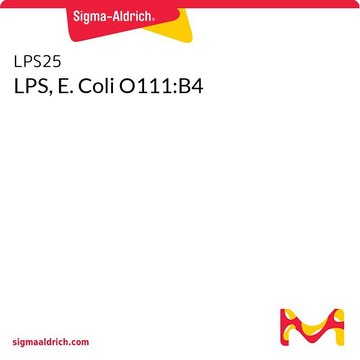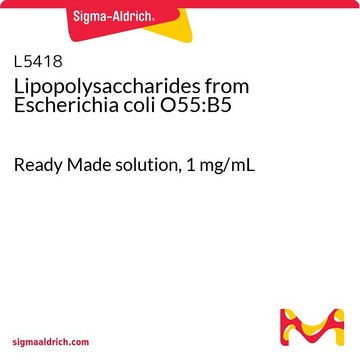L2880
Lipopolysaccharides from Escherichia coli O55:B5
purified by phenol extraction
Synonim(y):
LPS
About This Item
Polecane produkty
pochodzenie biologiczne
Escherichia coli (O55:B5)
Poziom jakości
Formularz
lyophilized powder
oczyszczone przez
phenol extraction
metody
cell based assay: suitable
zanieczyszczenia
<3% Protein (Lowry)
kolor
off-white to tan
rozpuszczalność
water: soluble
Zastosowanie
cell analysis
clinical research
life science and biopharma
Warunki transportu
ambient
temp. przechowywania
2-8°C
Szukasz podobnych produktów? Odwiedź Przewodnik dotyczący porównywania produktów
Opis ogólny
Zastosowanie
- to stimulate hepatocytes and non-parenchymal cells
- to stimulate the spleen and study the expression of the Malitaf gene in the fish blunt snout bream
- as part of the concanavalin A (ConA) and D-galactosamine/lipopolysaccharide (D-GalN/LPS) model of fulminant hepatitis to study the effect of the natural compound hesperetin
- to check the cell viability of human chorionic villi-derived mesenchymal stem cells (hCMSCs) by methyl thiazolyl tetrazolium (MTT) assay
- to induce oligodendrocyte toxicity to evaluate the neuroprotective effects of few compounds
- to induce sarcopenia in rats to evaluate the antioxidant effects of curcumin-loaded hydrophobic surface-modified hydroxyapatite
Działania biochem./fizjol.
Inne uwagi
produkt powiązany
Hasło ostrzegawcze
Danger
Zwroty wskazujące rodzaj zagrożenia
Zwroty wskazujące środki ostrożności
Klasyfikacja zagrożeń
Acute Tox. 2 Oral
Kod klasy składowania
6.1A - Combustible acute toxic Cat. 1 and 2 / very toxic hazardous materials
Klasa zagrożenia wodnego (WGK)
WGK 3
Temperatura zapłonu (°F)
Not applicable
Temperatura zapłonu (°C)
Not applicable
Środki ochrony indywidualnej
Eyeshields, Gloves, type N95 (US)
Wybierz jedną z najnowszych wersji:
Certyfikaty analizy (CoA)
Nie widzisz odpowiedniej wersji?
Jeśli potrzebujesz konkretnej wersji, możesz wyszukać konkretny certyfikat według numeru partii lub serii.
Masz już ten produkt?
Dokumenty związane z niedawno zakupionymi produktami zostały zamieszczone w Bibliotece dokumentów.
Klienci oglądali również te produkty
Produkty
An overview of human microbiome research, workflow challenges, sequencing, library production, data analysis, and available microbiome reagents to support your research.
Poznaj strukturę, funkcję i różnorodne zastosowania lipopolisacharydów. Odkryj ich rolę w bakteriach, specyficzność serologiczną i potencjał badawczy.
Nasz zespół naukowców ma doświadczenie we wszystkich obszarach badań, w tym w naukach przyrodniczych, materiałoznawstwie, syntezie chemicznej, chromatografii, analityce i wielu innych dziedzinach.
Skontaktuj się z zespołem ds. pomocy technicznej




